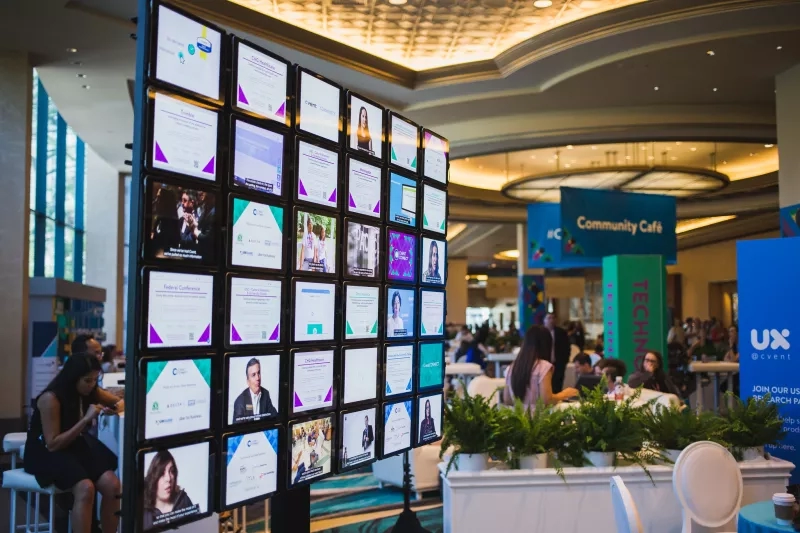Your event strategy is one of the most important parts of your meetings and events program. It’s almost impossible not to have an event strategy. Not having one, no matter the size and scope of your meetings or events, is setting yourself up for failure. An effective meetings and events program encompasses all event types (in-person, virtual, and hybrid) and comes down to your event strategy. It seeps into every aspect of your business. From event goals to proving event success, your strategy is the roadmap to what you hope to achieve with your meetings and events program and how you’ll measure that success.
What Is an Event Strategy?
Oftentimes, event strategy takes a backseat. Why? Planners get so bogged down by the day-to-day it can be challenging to focus on the bigger-picture strategic plan. Sound familiar?
Simply put, event strategy is an organization’s ability to develop a purposeful, measurable, and data-informed meetings and events program across all in-person, virtual, and hybrid events. This strategy should align with organizational goals. The effectiveness of an event strategy lies in the clarity and relevance of its key performance indicators (KPIs), how an organization decides which events to host and attend (the event selection process), how events are approved, and budget management.
Event Strategy Plan
While event strategy may seem abstract, an event strategy plan is concrete. It identifies the roadmap for the future year or quarters and areas of opportunity and goals. Your event strategy plan stems from a combination of business and organizational goals.
While unique to your department, your event strategy impacts and should align with overarching company goals. Event planning, while at times may seem haphazard, should have purpose and structure. Based on the types of events your organization deems relevant, your event strategy plan should ensure company goals align with the events hosted, in-person or virtually, to ensure event success and return on investment (ROI).
Event strategy planning can take place at any time of year but is most beneficial when done alongside company goal setting. The beginning of the year or start of a new quarter is a great time to sit down and work through your event strategy plan.
Event Strategy Template
Create an event strategy template that you can revisit in years to come. A framework offers a great base to get you started. Your template should follow a format recognized by stakeholders. If all plans take the form of Word documents with subheadings and addendums, lay out your template in the same way. If your company relies on PowerPoints, set up the skeleton of your plan in a series of slides. This template is meant to make planning easier – not add additional steps. If you start off on the right foot, you’ll have less work to do down the road.
As you begin building a template, think about the following:
- What are the organization’s primary business goals for the year?
- How can events impact or tie into those goals?
- What event type (in-person, virtual, or hybrid) will best meet event goals?
- How many events will be created during the year?
- What types of events will be in your plan?
- What is the desired output of your events?
- Does your team have adequate resources to carry out the anticipated number of events?
- Could event management tools be used to take your event program to the next level?
Define Your Event's Purpose
Each event you plan has a purpose. If it didn’t, then you wouldn’t receive stakeholder support. A few event objective examples are to network, gather leads, increase team morale, or educate. Whatever the event's purpose, it should tie back to your strategic event objectives.
Event Objectives
There are two levels of event objectives. One is at the individual event level, the other for your entire events program. Your event objective is tied to the primary purpose of the event. To be effective, your event objective should be clear, focused on an attainable goal, and relate to your overall event strategy.
Event Purpose Statement
The purpose of your special events should be clearly spelled out. An event purpose statement can do just that. By creating an event purpose statement for each event, you can identify level of importance, necessary spend, and organizational focus. Your event promotion and event marketing strategy will be commensurate with the event's purpose. Consider creating a purpose statement for each event that identifies the target attendees, the reasoning for creating the event, and the expected outcome. When you can, make the language of the event purpose statement align with company goals.
Set Clear Event Goals
The crucial first step to accomplishing your goals is to define them. The question is, “Why am I holding this event?” This is where you define your specific goals and objectives for your event.
Meeting Goals and Objectives
Some meetings have very clear goals by virtue of the meeting type. At a sales kickoff, for example, the goal is probably to let the sales team talk shop—trading competitive intel, team building, and getting motivated for the new sales period. Meanwhile, events like an annual general meeting can have varying objectives arising from a variety of long-term factors. It’s important to know those contextual details when defining your goals. Goals will change depending on whether the event will be hosted virtually, in-person, or hybrid, as all have different benefits and limitations. However, this doesn’t mean that you should brush off this first step for meetings that seem to have obvious goals. It’s important to define your goals in the context of each event, hence ‘event strategy.’
Align Company Goals and Event Strategy
Strategic event planning starts with identifying organizational goals and using the power of events to reach those goals. You know your organization’s goals. That’s a great place to start. If you want to grow revenue, your event should be centered around your product. While a networking happy hour might be fun, it is more likely to increase leads and face-to-face connections rather than securing closed deals. The type of event you choose to host should align with top company priorities.
Company Goals and Types of Events
- Grow Revenue: Trade show
- Build Brand: Thought leadership conference
- Decrease Organizational Turnover: Internal team building event
- Educate Clients: Virtual training sessions
Plan Your Calendar of Events
Timing is important. Product launches, membership sign-up times, and even the weather can play a role in attendee availability.
Take stock of:
- Industry events
- Competitor events
- Time of Year
- Attendee Location
Use Smart Goals
There’s nothing worse than planning an amazing event that, when it’s all over and done with, has no analytics tracked to measure success. Strategic event planning is about data and analytics. It’s about creating goals that will tell you if your event served the purpose it was meant to serve or if it flopped. You need to understand the data you can gather at your events and whether or not you’re tracking what you need to track.
- Set a Deadline: If the goal never ends, you can’t know if you succeed.
- Make it Measurable: Vague language doesn’t work. This is the time to set quantitative goals.
- Take Out Ambiguity: You shouldn’t question event success; it needs to be abundantly clear what is and isn’t a success.
- Make it Realistic: Base goals off of past events.
Performance Goals for Event Planners
Here are a few examples of the types of areas you could build your performance goals around.
- Event attendance
- Mobile event app engagement
- Sponsorship spend
- Leads capture
- Social media engagement
- Registrations
- Session attendance
- Submitted feedback surveys
- Overall satisfaction score
Event ROI: Understanding the Basics
Event goals and ROI are similar, though they don’t have to be the same. A goal is what you strive to achieve based on past performance, while event return on investment is the breakdown of how successful your event was based on indirect and direct costs.
Return on investment (ROI) is important to every business and a necessary part of proving the success of your event strategy. Often, event planners define ROI too narrowly. There are many event ROI metrics that come down to more than simple spend and revenue. Proving event ROI proves event success and creates event success metrics.
Key Performance Indicators (KPIs)
From user conferences to trade shows and roadshows to seminars, there are many different types of events an organization can host or attend. Generally, each event serves a different purpose, and it’s important to articulate what success looks like for each type of event. For example, trade shows are great ways to generate leads, while a roadshow may be held to accelerate the pipeline. Defining how you’ll measure success for each event type is central to communicating their value.
Direct & Indirect Costs
Direct costs include those items that are easily tracked by monetary spending. For instance, food and beverage, venue rental, travel, entertainment, décor, and marketing and promotional costs. You’re invoiced for all of these items after your event, and the cost is clear. Additionally, indirect costs are the costs of hosting your event. These costs are allocated based on resource assignment. Examples include salaries, allocation of technology expenses, and other shared resources. Planners can calculate these costs by using accounting processes such as activity-based costing. This method assigns attributed costs to products, services, and events. Work with your finance team for help with these calculations.
Direct Revenue
Also, easily understood and easy to calculate is direct revenue. This is money made directly from hosting or participating in an event. Direct revenue includes ticket sales or registration fees, sponsorship packages, onsite product sales, hotel commissions, advertising, fundraising, and government grants. This revenue would not be collected unless you hosted your event.
Opportunity Cost
Opportunity costs don’t show up on a company’s balance sheet but are part of every event. Opportunity costs arise from the scarcity of resources and how an organization chooses to deploy those resources, whether it’s people, products, or services. Because a company invests in an event, they forgo an investment into a digital marketing or a brand campaign. This alternative source of value represents an opportunity cost.
Attributed Revenue
Organizations market and promote their products through sessions, product showcases, and 1:1 meetings. Product positioning drives benefits over the long term, and as these deals close, they are booked as attributed revenue. Multiple attribution models exist. Work with your internal teams to determine what model makes the most sense for your organization.
Brand Equity
Last, and the hardest to calculate, is brand equity, which refers to the brand value of an organization. Brand equity is an intangible benefit; therefore, it is not measurable and offers longer tail rewards. A number of variables feed into this event driver, including awareness, quality, image, loyalty, and identity. Event attendance leads to customer loyalty, which fuels Customer Lifetime Value, the long-term profit from a customer over the course of their affiliation with the brand.
Event Marketing
Event marketing is a big part of making your event a success. Your event strategy is tied to event marketing. Event marketing can be thought of in two different ways. It can be considered event promotion for an individual event or how your event ties into your overall marketing mix.
Email Marketing Objectives
Event marketing objectives can be centered around a variety of factors. Building event technology into your marketing program can allow you to scale your program and create a wider reach.
Objectives:
- Event promotion to drive registration
- Retweets and shares
- Engagement on social media
- Email marketing success: open rates, click-through rate
Examples of Event Marketing Goals
You should have individual goals for each subset of planning. When it comes to marketing, your goals will be based on promotion. Depending on your event budget, you want to get the most for your money. Nowadays, marketing metrics are clearer. It’s easier to understand when you’ve been successful. Here are a few examples of marketing goals.
- Increase shares/reposts/comments on social media platforms
- Increase reach and post-engagement
- Increase click-through rate and decrease CPC on paid ads
- Increase form fills on the event website
Event Marketing Tools
There are a few tools that will make event marketing much easier. Event marketing ideas rely largely on technology and trends. Understand your resources and what you have the capacity to do when marketing your event. Don’t be afraid to try experiential marketing or a sponsored event activation onsite.
- Email marketing tools: These tools allow you to build, schedule, send, and track branded emails to drive event registration.
- Mobile event apps: At this point, a mobile event app is a necessity. They increase attendee engagement, provide a central hub for networking, allow attendees to create their own agendas, and offer opportunities for sponsorship and branding.
- Event website: An event website builder makes it possible to create a website with no coding knowledge. The event website is the hub of information for your event. Make sure it’s branded, enticing, and provides all the information needed.
- Social media tools: Consider investing in social event planning tools that allow you to schedule posts ahead of time. Creating a calendar of posts will provide a better insight into your social media event strategy for stakeholders and make your life easier.
Event Requirements Checklist
Event Master Plan
From a basic event checklist to a day-of-event checklist, event planners know their way around a list. It’s the best way to stay organized in the moment. Do what works best for you, but think about creating a few different checklists. From event execution to small to-dos, checklists can keep you organized. Don’t forget to make them digital! It might be more satisfying to check items off a handwritten list, but using one that’s accessible from your phone and computer and could be shared with team members will be more beneficial in the long run.
Understand Your Resources
There are a few things you have to understand before you can build out your event strategy. Your resources are all of those things that help you to accomplish your goals. You may have a little money, a lot of money, a small staff, or a big one, but you have to know what you’re working with. It’s unreasonable to think that you can put on 20 five-hundred-person events per year with a staff of two and a ten-thousand-dollar budget for the entire year. Without event management technology, having a clear grasp of your data and analytics is challenging.
Resources to Review:
- Money
- Time
- Staff
- Company support
- Education/Event Planning Knowledge
- Event Management Technology
Bringing It All Together
Building a cohesive event strategy takes time. It is made up of goals, proving event success, event marketing, the onsite experience, surveys, and more. Essentially, it is your entire meeting and event program, which includes all in-person, virtual, and hybrid events, rolled up into an overarching strategy that will help you reach organizational goals. To begin, start with where you’ve been. Historically, look at the events you’ve thrown and where successes and failures lie. Once you have your event strategy, look at your tech options. The right virtual event tool can bring your strategy to life. The Virtual Attendee Hub keeps everything on the same platform and makes strategizing and learning from past events easier than ever.
Virtual Event Strategy
Just like your in-person events, your virtual events should have a clear strategy and goal. You need to define why you are hosting this virtual event. If your virtual event does not have a key goal, why are you spending money on it? Make sure that your goal for your event will transfer well to a virtual setting. Do not simply translate your existing in-person event to a virtual event. Not all content will resonate virtually. Evaluate whether or not a virtual event is the best way to achieve your goals. Virtual event strategy, much like event strategy, gives your event focus and makes planning easier. A virtual meeting shouldn't exist simply for the sake of existing. With every virtual meeting, no matter how large or small, clarify your virtual event strategy.
Event Strategy Leads to Event Success
In order to plan your events strategically, you need to start early. It isn’t about throwing something together in the last minute just to host an event. Your content, your entertainment, your date, your location – everything needs to align with the event. More than that, you need the right resources to support your events so that your event strategy doesn’t hit any snags. Event management technology is critical at every stage of the planning process. Creating the perfect strategic events program takes time and a lot of trial and error.












